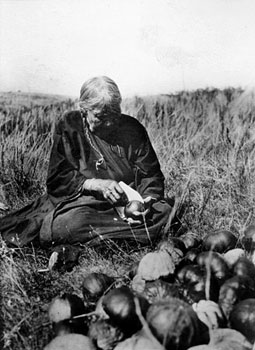
Owl Woman slicing squash SHSND# 0086-334Squash was harvested and thinly sliced. Each squash ring was placed on stick to dry in the sun. (Hidatsa, p. 48)
Harvested food was stored in several different ways. Some was placed inside the house, perhaps piled on unused beds or a platform between the beds. Some was placed in hide bags which hung from the rafters of the earthlodge. Food was stored for longer periods in storage pits which were located either in the floor of the lodge or just outside. The pits, usually bell-shaped, held dried corn, squash, and beans, as well as meat and other dried foods. (Hidatsa, p. 44)
Most scholarly and horticultural interest in Native American gardening is focused on corn which was an important crop for Indians as well as for European Americans and remains a very important commodity in modern farm markets. The Hidatsa raised nine varieties of corn. Each was planted separately in order to avoid cross-pollination and loss of the special qualities of each type. Some corn was eaten green (usually not the sugar type) and the rest was dried. Hard white corn was pounded, then boiled to make mush. Soft white corn and/or sugar corn was dried, ground and the meal then mixed with fat to make corn balls. Other corn types were roasted or boiled. (Hidatsa, p. 48)




